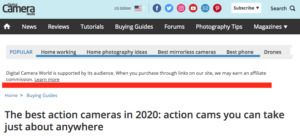Amazon Associates or affiliates helped the company develop into the powerhouse it is today. Nevertheless, affiliates are often engaged in shady activities such as deceiving consumers and building link farms. There is a good chance you’ve visited a website with lots of reviews for certain products and links directing to the product listing on Amazon for that product. What you have to understand is that the information on such websites is erroneous and the links help the creator of the bogus website make money.
Below, we’ll dig deeper into Amazon Associates Program and how it supports poor websites that are no better than link farms.
What Google Says About “Thin” Affiliates
Google believes that pure or “thin” affiliate websites create a frustrating user experience without providing additional value for web users. What is a thin affiliate? It is a website where most of the pages are made for affiliation. These websites contain limited original content or added value for users.
So, the margin of error is very wide here. Google also considers a site to be a pure affiliate website when it copies product description information directly from the original merchant without adding any original content or added value.
We argue that most of these websites fit into this category. The content is mostly rewritten from Amazon’s product descriptions and reviews.
What Does Amazon Require?
As for Amazon, it benefits greatly from affiliate programs. There are thousands of affiliate websites and the majority of them link to Amazon listings. Amazon does not want its associates to place affiliate links in emails, PDFs, or private groups. It also doesn’t like associates shortening the URL or cloaking the links.
In most cases, listing a sales price is a bad idea. If the price changes, the affiliate will experience problems so most affiliates never mention the actual price. Furthermore, Amazon wants affiliates to mention the disclosure statement. This means affiliates or associates have to tell visitors that they’re going to make money from the links.
The FTC Wants More
The FTC wants even more. The FTC wants associates or affiliates to have a clear disclosure on every post before the first outbound affiliate link. The only issue is that most affiliates reside outside of the United States so they may be able to escape the reach of the FTC. Plus, most American consumers do not take the time to check for this type of disclosure.
These rules cover bloggers and YouTubers as well. The FTC says “Putting disclosures in obscure places – for example, buried on an ABOUT US or GENERAL INFO page, behind a poorly labeled hyperlink or in a “terms of service” agreement – isn’t good enough”.
Unfortunately, most affiliate site owners do just that. In addition to this, the FTC says “Neither is placing it below your review or below the link to the online retailer so readers would have to keep scrolling after they finish reading.”
The FTC wants disclosure statements above all reviews.
So Many Rule Breakers
Unfortunately, Amazon has helped build the affiliate website marketplace. Most affiliates sign up for Amazon and stop there. And, Google further supports these sites. While it pretends it doesn’t appreciate “thin affiliates”, they’re plentiful and many of them rank at the top of Google’s search results.
Once I see an affiliate disclosure statement, I disregard everything else because the writer only wanted to make money. Nevertheless, some websites obey the rules. DigitalCameraWorld.com is one of those sites. I personally wouldn’t click on their links and buy anything because their opinion is tainted but the disclosure statement is at the top of the page.
It is easy to miss but it is there for everyone to see. T3.com and TomsGuide.com has a similar disclosure statement. Again, I wouldn’t personally click on these links or shop at Amazon for that matter but these sites are following the FTC’s guidelines and should be commended for that.
Below, you’ll find a list of rule breakers.
- GearHungry.com – Affiliate disclosure hidden in the bottom menu.
- JoshGoot.com – Link farm with disclosure at the very bottom of the site.
- ArchitectureLab.net – Disclosure link is hidden and too small. Can you find it?
- TheAbundantArtist.com – Not doing enough. “*Asterisk denotes affiliate link” is simply not enough and it is at the bottom of the page.
- BestSeekers.com – Again, disclosure statement is hidden at the bottom. It says nothing about the site owner making money from the links.
- HelloArtsy.com – Couldn’t find an affiliate disclosure at all.
- Heavy.com/gifts/2018/10/gifts-for-seniors/ – Disclosure link at the bottom and in small writing. Not enough. No real substance and a bunch of Amazon affiliate links.
- FamilyLivingToday.com – Another affiliate site with the affiliate commission statement at the bottom.
- ThisGiftsForMen.com – No disclosure statement found.
- GiftSeekr.com – Affiliate disclosure hidden in the footer menu.
It is clear that many webmasters are breaking the terms set forth by the FTC. Despite these sites being “thin” affiliate sites, Google continues pushing them up the search results thanks to spammy backlinks and other black hat activities.
Be warned! Do not use these websites believing the freelance writers tested the products in advance. They likely did not. Their goal is to place the highest priced item at the top so they’ll make the most money.
Jay Skelton is an independent crime journalist with a passion for covering the uncovered and the under covered.


0 Comments Leave a comment